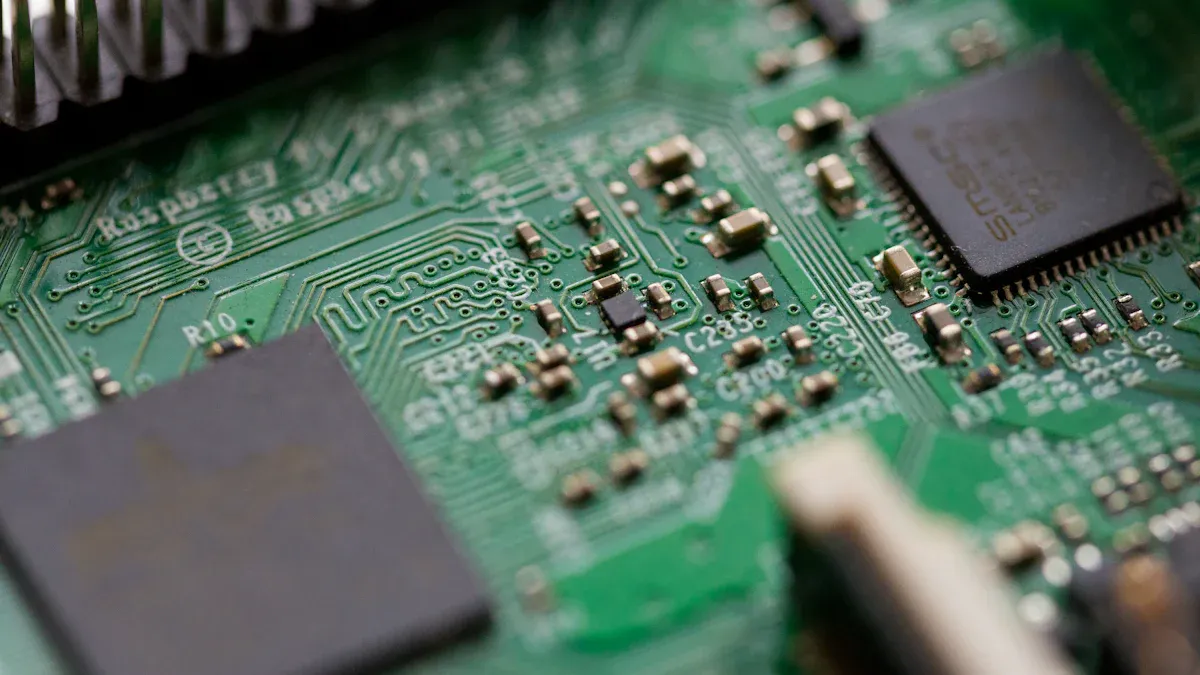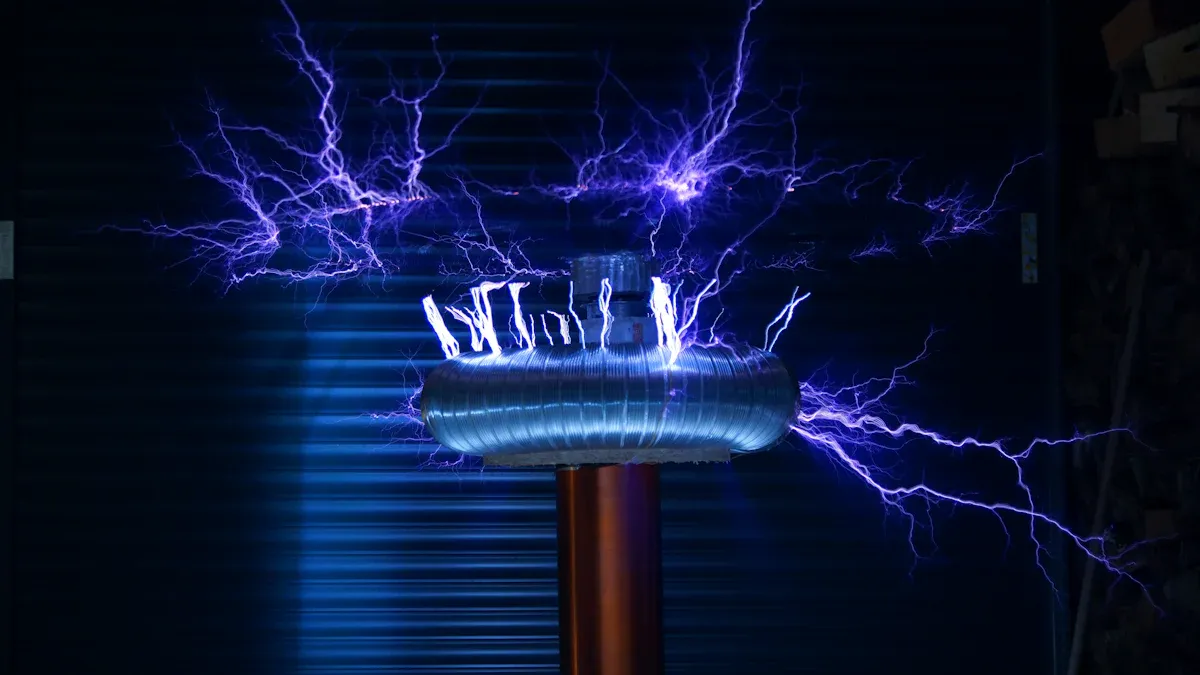What ESD Protection Chips Do in Electronic Circuits

An ESD Protection Chip helps you shield your electronic circuits from sudden spikes of static electricity. Without this protection, sensitive parts inside your devices can get damaged or even stop working. For example, walking across a synthetic floor can build up as much as 20,000 volts of static charge, enough to harm tiny components. More than one-third of field failures in electronics come from ESD events. You rely on ESD Protection Chips to keep your devices safe and working longer.
Key Takeaways
ESD protection chips guard electronic circuits from sudden static electricity spikes that can damage sensitive parts.
These chips react very fast to redirect harmful surges away from important components, keeping devices safe and reliable.
Placing ESD protection chips close to connectors and vulnerable points in a circuit gives the best defense against static damage.
Different types of ESD protection devices, like diodes, MOSFETs, and varistors, offer options for various needs and designs.
Choosing the right chip and design helps balance protection, cost, and circuit performance for longer-lasting electronics.
ESD Protection Chip Basics

What Is ESD?
You may have felt a small shock when you touched a metal doorknob after walking on a carpet. This shock comes from electrostatic discharge, or ESD. ESD happens when built-up static electricity suddenly moves from one object to another. In electronics, this can mean a burst of electricity jumps into a circuit. Even a tiny spark, too small for you to feel, can damage sensitive parts inside your devices.
Scientists have studied ESD using advanced tools and experiments. For example, researchers use computer simulations and special tests to see how ESD affects microchips. They found that ESD can cause a fast flow of current, heat up parts of a chip, and even break tiny wires inside. These studies show why you need to protect your electronics from ESD. An ESD Protection Chip helps stop these sudden surges from reaching important parts of your circuit.
Tip: ESD can happen in less than a microsecond, so your devices need protection that reacts quickly.
ESD Threats in Electronics
You face many ESD threats when you use or build electronic devices. Static electricity can build up on your body, your clothes, or even the air around you. When you touch a device, the charge can jump into the circuit. This can cause the device to stop working or fail later.
In real-world situations, ESD can create high voltages and strong electric fields. These can travel through small openings, cables, or even through the air. Sometimes, ESD does not cause instant damage but creates hidden problems that show up later. For example, strong electric fields can harm parts of a chip without a visible spark. This makes ESD hard to detect and even harder to fix.
A table below shows common ESD threats:
ESD Threat Type | How It Affects Electronics |
|---|---|
Direct Discharge | Burns or breaks tiny circuit parts |
Electromagnetic Pulse | Causes interference or malfunctions |
Field-Induced Damage | Creates hidden defects |
You need to use special tools and strategies to protect your devices. An ESD Protection Chip gives your circuit a safe path for static electricity, keeping your electronics safe and reliable.
How ESD Protection Chip Works
Operating Principle
You need your circuits to react fast when static electricity strikes. An ESD Protection Chip gives your circuit a low-impedance path for the sudden surge. When a high-voltage pulse hits, the chip quickly shunts the extra energy away from sensitive parts. This action keeps your devices safe from damage.
Most ESD Protection Chips use special components like TVS diodes or varistors. These parts act like safety valves. They stay off during normal operation but turn on instantly when they sense a voltage spike. The chip then directs the harmful current to ground or to a power rail, away from your important electronics.
Researchers have tested these chips using models like the Human Body Model (HBM) and the Charged Device Model (CDM). These tests show how well the chip protects against real-world static shocks. Experts also use standards such as IEC 61340-5-1 to make sure the chips work as promised. You can see some of these studies and tests in the table below:
Evidence Category | Description |
|---|---|
Empirical Studies | Research on ESD materials, device sensitivity, and failure mechanisms. |
Technical Measurements | HBM, CDM, MM, and TLP tests to check ESD sensitivity and chip effectiveness. |
Standards and Methodologies | IEC and ESDA/JEDEC standards for testing and qualifying ESD protection devices. |
Real-World Validation | Analysis of ESD damage in manufacturing and handling, showing the need for ESD control. |
Performance Considerations | Studies on balancing ESD protection and high-frequency performance (up to 60 GHz). |
Note: ESD Protection Chips must respond in less than a billionth of a second to stop damage.
Circuit Placement
You get the best protection when you place ESD Protection Chips at the right spots in your circuit. The most vulnerable points are usually the input/output (I/O) pins, power pads, and ground pads. Placing the chip close to these areas helps stop static surges before they reach sensitive parts.
Researchers have found that the way you connect and position these chips makes a big difference. Here are some key findings:
You can use circuit simulators to see how ESD surges travel from the point of contact to the rest of your device.
By testing different placements, you can find the best spot for each chip.
You should choose the right type of ESD protection device, such as diodes or MOSFETs, for each location.
Placing chips at system and PCB levels reduces the risk of ESD damage.
Real-world tests on memory modules and motherboards show that good placement lowers the chance of failure.
Tip: Always place ESD Protection Chips as close as possible to the entry points of your circuit.
Discharge Pathways
When static electricity enters your device, it needs a safe way out. ESD Protection Chips create controlled discharge pathways. These paths guide the surge to ground or another safe area, keeping your main circuit safe.
Different discharge pathways can affect how well your protection works. The table below shows some common pathways and what happens during ESD events:
Discharge Pathway | Key Technical Observations | Impact on ESD Protection Effectiveness and Testing Repeatability |
|---|---|---|
Air Discharge (Spark) | Current changes a lot due to spark length, humidity, and speed. | Test results can vary; sometimes one spark damages the device, other times it does not. |
Wiring Harness/Cable | Cables act like transmission lines, causing reflections and waveform changes. | Unexpected changes can lead to device failures if not considered in design. |
Common Mode Choke (CMC) | Shows nonlinear behavior under ESD, causing complex current patterns. | Can make ESD protection less predictable and harder to test. |
Series Resistors | High resistance limits current but can spark over, acting like air discharge. | May not always protect as intended; can complicate test results. |
Return Path Setup | Changes in grounding and setup affect how current returns, changing the ESD waveform. | Different setups can change test results, making it hard to repeat tests in different labs. |
You should always design your circuit so that the ESD Protection Chip provides a clear and direct path to ground. This setup helps ensure that static surges do not take unexpected routes and damage your device.
Types of ESD Protection Devices

Diode-Based
You often find diode-based devices as the first line of defense in ESD protection. These diodes act like one-way gates for electricity. When a static surge hits, the diode quickly directs the extra current away from sensitive parts. You can use them for both positive and negative ESD events by placing complementary diodes in your circuit.
Here is a table comparing diode-based ESD devices with other common types:
Device Type | Key Technical Specifications | Comparative Insights |
|---|---|---|
Diode-based ESD | Geometry-dependent current density, up to 3 kV HBM robustness | Lower cost, needs complementary diodes for full polarity protection, higher capacitance in small widths |
NMOS-based ESD | Uses parasitic NPN transistor, higher capacitance | Handles both polarities, better current capability, layout affects robustness |
Ceramic MLVs | Capacitance from 1 pF to >100 pF, robust up to +150 °C | Dual function as EMI filter, higher cost, suitable for automotive and high-temp uses |
Tip: Diode-based ESD protection works well for low-cost, low-capacitance needs, but you must check the layout to avoid unwanted side effects.
MOSFET and SCR
You can use MOSFET and SCR (Silicon Controlled Rectifier) devices for stronger ESD protection. MOSFET-based solutions use special transistor effects to handle large surges. SCRs act like fast switches that turn on when a surge appears, sending the current safely to ground.
Experimental results show that you can improve SCR performance by changing the MOS transistor layout. For example, a PMOS-triggered SCR can achieve the lowest trigger voltage and fastest turn-on speed. This means your circuit gets protected almost instantly. Some SCR designs withstand up to 6.5 kV ESD stress and do not need extra process steps, making them easy to add to standard chips.
You can see how different SCR techniques compare:
Device Type / Technique | Key Performance Metrics | Experimental Highlights |
|---|---|---|
Double-triggered SCR (DT_SCR) | Reduced switching voltage and turn-on time | Faster protection in modern chips |
Substrate-triggered SCR | Turn-on time down to 7.8 ns | High ESD stress tolerance |
PMOS-triggered SCR | Lowest trigger voltage, fastest turn-on | No special process needed, avoids latchup |
HIPTSCR/HINTSCR | Trigger voltage ~12 V, trigger current >200 mA | High robustness with small layout |
You should consider MOSFET and SCR-based protection if your design faces high ESD risks or needs fast, reliable switching.
TVS and Varistors
TVS (Transient Voltage Suppression) diodes and varistors give you flexible options for ESD protection. TVS diodes react in nanoseconds, clamping voltage spikes before they reach your sensitive electronics. Manufacturer data shows that TVS diodes offer fast response times, low leakage current, and strong peak power ratings. You can find detailed application notes and test results that prove their reliability in real-world circuits.
Ceramic multi-layer varistors (MLVs) also respond quickly and can handle higher temperatures, up to +150 °C. You can control their capacitance during manufacturing, which lets you use them as both ESD protection and EMI filters. This saves space on your circuit board.
Here is a quick comparison:
Feature | TVS Diodes (Diode-based) | Ceramic MLVs (Multi-layer Varistors) |
|---|---|---|
Response Time | Low nanosecond range | Similar low nanosecond range |
Capacitance | Lower, less controllable | Higher, controllable (1 pF to >100 pF) |
Temperature Robustness | Degrades above +25 °C | Robust up to +150 °C |
EMI Filtering | Not typical | Can replace capacitors, saves space |
If you need both ESD protection and EMI filtering, ceramic MLVs can be a smart choice. For fast, proven ESD defense, TVS diodes remain a top pick.
Selection and Integration
Choosing the Right Chip
You want to pick an ESD Protection Chip that matches your circuit’s needs. Start by checking the voltage and speed requirements. Choose a chip with a clamping voltage just above your circuit’s normal voltage but below the maximum safe level for your parts. Fast switching speed is important because it helps stop voltage spikes before they cause harm. For one-way signals, use unidirectional diodes. For data lines, use bidirectional types.
Place the chip close to where static electricity might enter, like connectors or ports. This helps the chip react quickly.
Other important factors include package type and current handling. Surface-mount packages save space, while through-hole types handle more power. Always balance cost and performance. Follow standards like IEC 61000-4-2 or MIL-STD-883 to make sure your choice meets industry rules.
Design Considerations
You need to think about several things when adding ESD protection to your design. The table below shows how different devices work and what makes them special:
Protective Device | Role and Characteristics |
|---|---|
Diodes | Good for low-voltage protection; quick to turn on; may wear out under reverse bias. |
Grounded-Gate N-Channel MOSFET | Works well in CMOS circuits; layout changes improve current handling and lower heat. |
Silicon-Controlled Rectifiers (SCRs) | Strong protection; new designs avoid latch-up problems. |
Other Devices | Varistors, spark gaps, and gas tubes add extra safety in special cases. |
You should keep traces short and direct. Use a low-inductance ground path to help the chip work fast. Simulation tools let you test your design before building it. These tools check how your ESD Protection Chip will perform during real ESD events.
Application Examples
Many companies use ESD protection in their products and factories. Apple, Dell, and Toyota use special furniture and training to keep devices safe. A large computer maker built a server rack system with ESD protection for testing. Linear Technology set up a program to test and improve ESD safety in every step, from design to field service. They use regular testing and employee training to keep their products reliable.
Regular checks and updates help you keep your ESD protection strong over time.
You play a key role in keeping electronics safe from static damage. Today’s circuits face new challenges as chips become smaller and more complex.
Advanced packaging and more connection points increase ESD risks.
Traditional protection methods can slow down circuits or raise costs.
New solutions, like interposer-based protection, help manage these risks and support better performance.
Modern design tools now help you build stronger, more reliable devices.
Make ESD protection a top priority in every design to ensure your electronics last longer and work better.
FAQ
What happens if you do not use an ESD protection chip?
You risk damaging your electronics. Static electricity can destroy sensitive parts inside your device. You may see sudden failures or hidden problems that show up later. ESD protection chips help you avoid these costly issues.
Can you use ESD protection chips with any circuit?
Yes, you can add ESD protection chips to almost any circuit. You just need to choose the right type for your voltage and speed needs. Always check your circuit’s requirements before you pick a chip.
How do you know where to place an ESD protection chip?
Place the chip close to connectors, ports, or any spot where static electricity might enter. This helps the chip react quickly and keeps your sensitive parts safe.
Do ESD protection chips affect your circuit’s performance?
Most ESD protection chips have very low capacitance and fast response times. You usually will not notice any change in your circuit’s speed or signal quality if you select the right chip.
Are ESD protection chips expensive?
You can find many affordable options. Basic diode-based chips cost just a few cents each. More advanced types may cost more, but they protect your devices and save you money in the long run.
See Also
Understanding Communication Chips And Their Operational Mechanisms
Latest Developments In Automotive-Grade Semiconductor Chip Innovations
A Comprehensive Guide To Power Supply Chips And Functions
Exploring Static RAM Memory Chips And Their Functional Process
Strategies Analog Devices Uses To Maintain Strong Chip Supply
